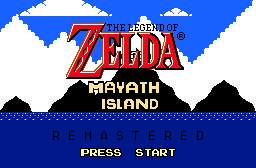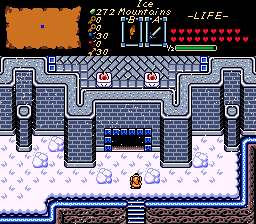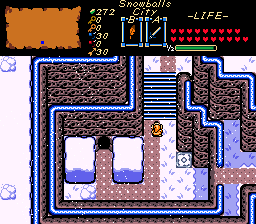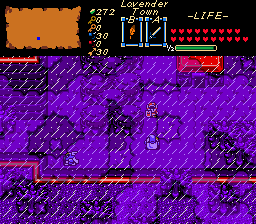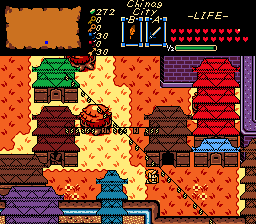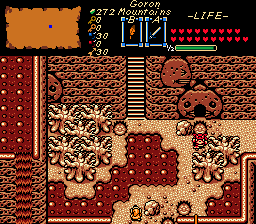Just finished up this quest and yeah it was quite an enjoyable experience with some odd things here and there. I'll start with the positive stuff which is that the quest has some pretty cool dungeon design. There are some issues but generally they were quite creative and fairly complex, but not too long and didn't drag out enough (although Level 7 was kind of annoying after a while). The custom items and concepts were very awesome, I really enjoyed using the new items throughout the quest. The overworld was neat too with different areas connecting up with the warp zone which was very convenient. I can certainly see a lot of inspiration from other quests so it kinda felt like I was playing a bunch of different quests mashed together at some points lmao. The difficulty was also generally fine although I do feel there's a bit of imbalance in some places (for example the first boss was ridiculously difficult compared to everything else in game) so some tweaks can be beneficial here and there. The optional content was really neat too, and I absolutely loved that dungeon for the Yellow Tunic I think it was called. The postgame dungeon was also very fun.
So while I did enjoy the dungeons, I think my biggest problem with them is that it can be difficult to know where to go sometimes, since there are many instances where you hit a switch and then you don't know what it does. This is a persistent problem throughout the ENTIRE quest and sometimes got frustrating having to do loops around the dungeon to see maybe one random door open. Sometimes there's signs on where you can go with colour-coded switches and stuff and other times you get text boxes to let you know something happened in a vague area. That is fine but I wish all of them were like this since otherwise it felt very inconsistent and annoying. I've already mentioned that the overworld was neat, but imo it was the weakest part of the quest for me since it generally felt like a straight line without much branching paths (if any) and they were all fairly small too. Things also felt quite cramped because you usually have a lot of enemies in narrow places, so I'd suggest to reduce the enemy numbers quite a bit. The single most annoying thing was the stealth segments (mostly the thieves' place) because the sensitivity on the guards/thieves were REALLY bad and just made things not fun in the slightest. If there's some way to modify the script to make them less sensitive then I'd suggest to please do that. If that isn't possible then I understand.
Also another issue I have is the general palettes of the quest, where sometimes they're fine but others can be kind of difficult to look at since some can be a bit too bright for me (see the desert mini dungeon for example). I'd also work to varying up the monochrome palettes since more colour variety would benefit a lot for the quest's dungeons. And one last thing, while the custom items were really cool, some had pretty annoying bugs, although I'm not sure how much of this was out of your control. For example, the Deku Leaf is really cool, but if you use it onto a pit or lava, you'll find yourself endlessly falling into it until the whirlwinds disappear, which costed a few deaths. The Old Rod is also really cool but for some reason it launched me into lava when using it sometimes instead of pushing blocks. I found that leaving and re-entering rooms fixed that problem but yeah that should be looked into if possible.
As for weird oddities and bugs, I compiled a quick Imgur album to look over for some fixes. You can find that here
Overall this was fun, sometimes a bit rough around the edges with some frustrating item bugs and some annoying dungeon design in places but I still enjoyed it. I'm torn between anywhere in the 3.5-4 range so I guess I'll just round it up to a 4/5. Nice work, certainly a massive improvement over the original game.
Zelda: Mayath Island Remastered
Overview
Feature Quest
Creator:
TheRock
,
Sans
Genre: Scripted
Added: 27 Jun 2020
Updated: 19 Oct 2021
ZC Version: 2.53
Downloads: 692
Rating[?]:

|
Download Quest (9.72 MB) |
Information
This Quest Uses enhanced music. You can download it here: https://www.mediafir... Music.zip/file
About Reviews Comments Forum Topics
Description
Mayath Island Remastered is a game with many different areas to explore, dungeons to conquer, secrets to find, and a vast world to discover.
The game includes:
12+ hours of gameplay
Warping system
Challenging, complex dungeons
Update 1# Fixed a bug where you could use a key in the wrong place.
Update 2# Fixed the Desert palace boss so now you start in the right place if you die.
Update 3# Changed the bad ending so now the player doesn't lose their progress.
Update 4# Fixed the house music.
Update 5# Fixed a odd side warp that shouldn't be in Celestia.
Update 6# Fixed a screen in level 8 I thought I already fixed.
Update 7# Fixed a house in Snowbell City.
Update 8# Fixed 5 small bugs.
Update 9# Added a intro with Sans.
Update 10# Fixed where you can walk in the screen in level 6 with the boss door.
Update 11# Fixed a bug in the snow mountain where the player could skip some content.
Update 12# Fixed some layering problems and made so the player can't skip a section in level 7. Made so the player doesn't get stuck after a puzzle in level 6. Made so the player can't go to the right on one of the screens in the desert.
Update 13# Made so now the player can get a full 20 hearts
Update 14# New dungeon added. Magic Shield added, and New music added
The game includes:
12+ hours of gameplay
Warping system
Challenging, complex dungeons
Update 1# Fixed a bug where you could use a key in the wrong place.
Update 2# Fixed the Desert palace boss so now you start in the right place if you die.
Update 3# Changed the bad ending so now the player doesn't lose their progress.
Update 4# Fixed the house music.
Update 5# Fixed a odd side warp that shouldn't be in Celestia.
Update 6# Fixed a screen in level 8 I thought I already fixed.
Update 7# Fixed a house in Snowbell City.
Update 8# Fixed 5 small bugs.
Update 9# Added a intro with Sans.
Update 10# Fixed where you can walk in the screen in level 6 with the boss door.
Update 11# Fixed a bug in the snow mountain where the player could skip some content.
Update 12# Fixed some layering problems and made so the player can't skip a section in level 7. Made so the player doesn't get stuck after a puzzle in level 6. Made so the player can't go to the right on one of the screens in the desert.
Update 13# Made so now the player can get a full 20 hearts
Update 14# New dungeon added. Magic Shield added, and New music added
Story
Play the game to find out!
Tips & Cheats
None.
Credits
The credits are at the end of the game.

